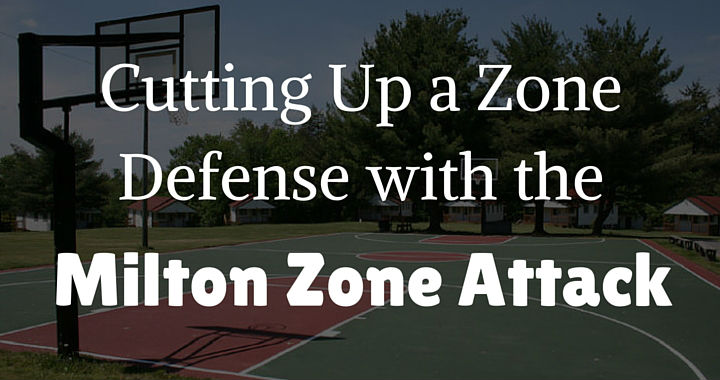 Today I will share one series of concepts I have developed to attack a zone.
Today I will share one series of concepts I have developed to attack a zone.
The concept I am sharing here will work against any zone with minor adjustments to deployment of players, spacing and knowing who to screen. That said, for the sake of keeping this post simple and understandable, I will make reference to attacking a 2-3 zone.
I would also like to note before starting that I love talking X’s & O’s, especially when it comes to attacking zones. Hence, anyone who finds these concepts interesting who would also like to talk about them in more detail, I would enthusiastically invite you to reach out to me through my coaching & leadership site at www.coachmattkramer.com. I am a firm believer that when coaches share with other coaches, we all win!
I hope every coach who gives this a look finds something useful!
The Premise:
I heard legendary Syracuse Head Coach Jim Boeheim once explain that he favors playing a zone because most coaches best offensive stuff is designed to be run against man-to-man defense.
Whereas this is not a direct quote, the message is pretty clear to me: most coaches build a comprehensive offensive system or package against man-to-man defense and practice exhaustively against man-to-man, so when ‘a Syracuse’ jumps up on a schedule, there is perhaps less creativity in the way most teams attack a zone, which makes it easier, in a manner of speaking, for a zone team to prepare.
Now, I’m not suggesting I have found an answer to crack the vaunted Syracuse zone because that zone is the best 2-3 zone in the world, coached by the best coach to ever coach the 2-3 zone, executed by players the basketball gods created to be the best at defending in the 2-3 zone. What I am suggesting is that when my team runs into a team that favors the zone, we are going to implement a scheme that tests that zone’s ability to defend all aspects of good offensive basketball.
With no disrespect meant to anyone, I have found that many zones prey on the ‘vanilla’ attack of most teams’ zone offenses and, thus, are not coached to defend all the possibilities of our zone offensive approach when we execute well.
Here are the 5 key ideas that make up the foundation of the Milton Zone Attack:
1. Ball movement
2. Spacing and varied deployment of players
3. Screening the zone in various places to extend it.
4. Overloading to distort the zone
5. Cutting through the zone to confuse it
Base Concepts:
We have two different base concepts we operate out of against any zone: A one-post continuity concept we call “Hoban” (named after the high school I attended); and a standard two-post look with a one-guard front and two on the wings we call “Double.”
Today, I am going to give you the basic continuity to our “Hoban” zone offense and a couple wrinkles we run out of it to really test any zone defense.
“Hoban”
Hoban starts with a point, two wings, a high post deployed on the foul line and a player on the low block.
For the sake of making things easy to follow, call the man on the point the ‘1’; the man on the right wing the ‘2’; the man on the left wing the ‘3’; the man in the high post the ‘5’; and the man on the block the ‘4’. (I stress here that we are NOT locked into this numbering; I do a ton of adjusting and manipulating of our players to create different opportunities and mismatches and I encourage any coach using this stuff to do the same.)
The Continuity:
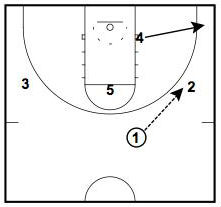 a). The ball starts in the hands of the 1 and he will enter to a wing… let’s say to 2 on the right wing.
a). The ball starts in the hands of the 1 and he will enter to a wing… let’s say to 2 on the right wing.
On the entry to the wing, 4 creates a ‘heavy side’ by moving into the ball side corner which immediately puts the defense in an overload situation.
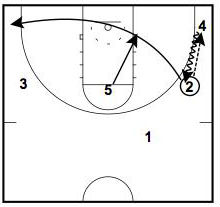 b). 2 passes the ball from wing to 4 in the corner and then 2 cuts to the ball side block for a possible return pass.
b). 2 passes the ball from wing to 4 in the corner and then 2 cuts to the ball side block for a possible return pass.
Assuming 4 does not have a shot, he checks 2 on the ‘Hoban cut’ as he dribbles up out of the corner attacking the top defender in the 2-3.
If 2 does not receive a pass on the ‘Hoban cut’ he slides through to the back side corner and 5 dives to the ball side box as the ball is being dribbled up out of the corner.
The ‘dive’ to the box by the 5 off of 2’s Hoban cut creates a tricky situation for the zone to defend and will often result in a 1 on 1 opportunity on the block. (While all this is going on, 3 should be sitting on the back side wing in a soft spot looking to catch a skip pass and 1 should be moving to a spot where he can receive the reversal pass.)
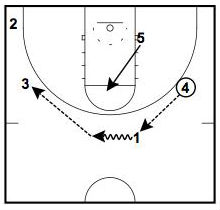 c). 4, having dribbled up to the right wing, reverses the ball back to 1 on the point.
c). 4, having dribbled up to the right wing, reverses the ball back to 1 on the point.
When the ball comes back to the 1, 5 moves back to the high post.
1 has 4 basic options when he catches the reversal pass: shoot; check the high post for a direct entry; attack the top of the zone going away from the pass and make two defenders play him; and/or reverse the ball to 3 on the left wing.
Assuming he chooses to reverse the ball to 3, it is easy to see the left side of the floor has now become the ‘heavy side’ of the floor, 2 having cut through to the left corner. At this point, the continuity continues.
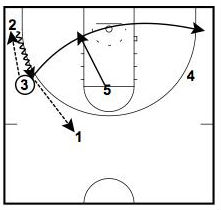 d). 3 passes from left wing to 2 in the corner then Hoban cuts to the left block as 2 dribbles up out of the corner checking the cut.
d). 3 passes from left wing to 2 in the corner then Hoban cuts to the left block as 2 dribbles up out of the corner checking the cut.
If 3 does not receive the pass on the Hoban cut, he slides through to the back side corner and 5 dives to the vacated left block with two checking him for a post entry.
If two does not enter the post or skip to 4 on the weak side wing, he reverses the ball back to 1 again and the continuity continues with the heavy side now back on the right side with 4 on the wing and 3 in the corner.
Pause for a few teaching points:
1. Get the Ball Moving
I like to remind the players to “get the ball moving” in this concept because things tend to open up in this continuity after a reversal or two.
The last thing I want is for the players to get sticky fingers and hold the ball too long initially.
We want to get our continuity because it get the zone moving, which makes the defense more susceptible to all of the cuts and dives and dribble penetration we are looking to set up.
2. Remember the Skip Pass
The skip pass from side to side, bypassing the point reversal is always a great idea if it opens up.
Oftentimes, this skip creates a quick ‘one more’ to the corner for a wide open corner 3-pointer and it puts the defense in scramble mode.
3. Point Guard Exchange
We often times leave our 1 man on the point because he is best able to attack the top of the zone on reversal, but we will also exchange the one with the weak side wing after he reverses it to get a shooter on the point and/or simply to give the defense one more movement to worry about defending. (There is also a screening option from wing to point here that is very easy to add on that weak side point to wing exchange.)
Wrinkles out of Hoban:
“Baseline” call:
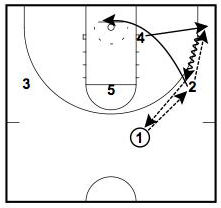 a). Ball is passed from 1 on the point to 2 on the wing.
a). Ball is passed from 1 on the point to 2 on the wing.
4 slides to the ball side corner as he always does to create the ‘heavy side.’
2 passes to 4 in the corner then makes the Hoban cut to the ball-side block as 4 checks him and dribbles up out of the corner toward the wing.
While this is going on, 1 moves so he can receive an easy pass from 4.
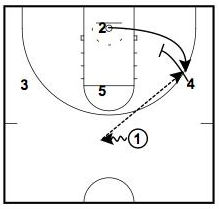 b). 4 passes to 1 and 1 quickly ‘freeze dribbles’ the zone by going one hard dribble away from 4’s pass. (The freeze dribble is crucial because it gets the zone to move toward the normal continuity of the offense and sets up the screening that is about to take place.)
b). 4 passes to 1 and 1 quickly ‘freeze dribbles’ the zone by going one hard dribble away from 4’s pass. (The freeze dribble is crucial because it gets the zone to move toward the normal continuity of the offense and sets up the screening that is about to take place.)
2 (instead of sliding through to the back side corner like he normally would) stops under the basket and pops back to the strong-side of the screen set by 4 for an open jump shot. 4 will screen the man who was just guarding him in the zone, typically the bottom man in a 2-3 zone. 1 reverse pivots and throws back to the 2 for a shot coming off of 4’s screen.
4 will screen the man who was just guarding him in the zone, typically the bottom man in a 2-3 zone. 1 reverse pivots and throws back to the 2 for a shot coming off of 4’s screen.
1 reverse pivots and throws back to the 2 for a shot coming off of 4’s screen.
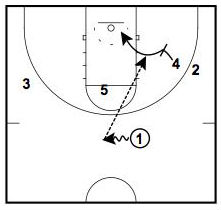
c). If the defender jumps over the screen set by 4, we teach the 4 to let him do it, in other words don’t fight with the defender and get caught for an illegal screen.
If the defender does this, it allows the screener (4) to slip inside the zone for a direct pass from 1. (Often times what happens here is that this screening variation gets the 2 open on the first run for an easy look at a three-pointer then we get the slip on the second run).
Either way, we are giving the defense a myriad of things to guard.
Over time, this tends to extend even the best of zones, which allows a variety of windows for us to pass and drive through.
“Baseline Run It” Call:
I like to have what I call a “Run It” for every set we run against a zone and man-to-man defense.
When the words “Run It” are added after the call it tells our players we are running a counter to the initial concept – often times a lob or back door wrinkle.
In this case, “Baseline Run It” is a counter that results in a lob for an easy basket (Last year that meant an alley-oop dunk for our Navy-bound scholarship forward Mo Lewis.)
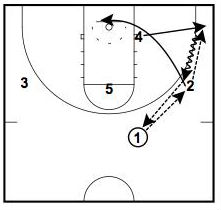 a). Same as with “Baseline,” “Baseline Run It” starts with a pass from 1 to 2 on the wing and 2 passing to 4 in the ball side corner on the heavy side.
a). Same as with “Baseline,” “Baseline Run It” starts with a pass from 1 to 2 on the wing and 2 passing to 4 in the ball side corner on the heavy side.
2 then makes his Hoban cut through to the ball side box as 4 dribbles up out of the corner and looks to reverse the ball to 1.
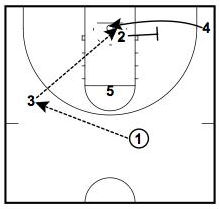 b). As the pass goes to 1 on this wrinkle, we are preying on the defender reading the play and making sure not to bite and suck in on the freeze dribble.
b). As the pass goes to 1 on this wrinkle, we are preying on the defender reading the play and making sure not to bite and suck in on the freeze dribble.
3, instead of sitting on the back side wing as he normally would, moves a bit higher, perhaps as high as the lane-line extended to receive a reversal pass from 1.
This time, instead of freeze dribbling, the 1 quickly hits 3; 2, who had stopped on the block after the Hoban cut sets a back screen on the bottom man of the zone as the ball is passed to 3 and 4 runs off the baseline side of the screen toward the basket for the lob pass.
The 5, who has remained in the high post, typically occupies the attention of the middle man in the zone enough to give the 4 a free run at dunking the lob.
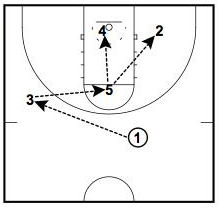 c). If the middle defender in the zone stays home and takes the lob away – very unlikely the first couple runs – we like 3 to hit 5 in the high post, 4 to continue through to pin the baseline defender outside on the ball side and the 2, who set the screen on the baseline defender on the right side to reverse pivot and seal his man outside. This puts the ball in the hands of the 5 at the high post with two great opportunities to pass to open players (2 & 4) near the basket inside a zone that has been extended and compromised.
c). If the middle defender in the zone stays home and takes the lob away – very unlikely the first couple runs – we like 3 to hit 5 in the high post, 4 to continue through to pin the baseline defender outside on the ball side and the 2, who set the screen on the baseline defender on the right side to reverse pivot and seal his man outside. This puts the ball in the hands of the 5 at the high post with two great opportunities to pass to open players (2 & 4) near the basket inside a zone that has been extended and compromised.
This puts the ball in the hands of the 5 at the high post with two great opportunities to pass to open players (2 & 4) near the basket inside a zone that has been extended and compromised.
Final Thoughts:
Hoban and the “Baseline” and “Baseline Run It” wrinkles that we run out of that basic continuity are just a few examples of how we go about attacking a zone. In my experience, unless a zone is exceptionally well coached and a team is 100% committed to it, these concepts are enough. Taught effectively – obviously with capable players – this stuff will cut up any zone.
However, there are teams at the higher levels who are very well-schooled in their zones, so we are ready with a package of other concepts to make sure we are prepared to vary our attack for any situation.
I hope the ideas I have given here are found to be useful. Anyone who would like to discuss these ideas further or talk about the other concepts we use against the zone – or anything else basketball – please visit my site at www.coachmattkramer.com where all content is 100% free.

